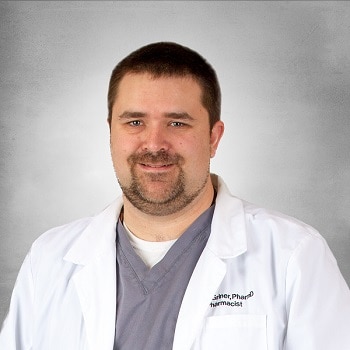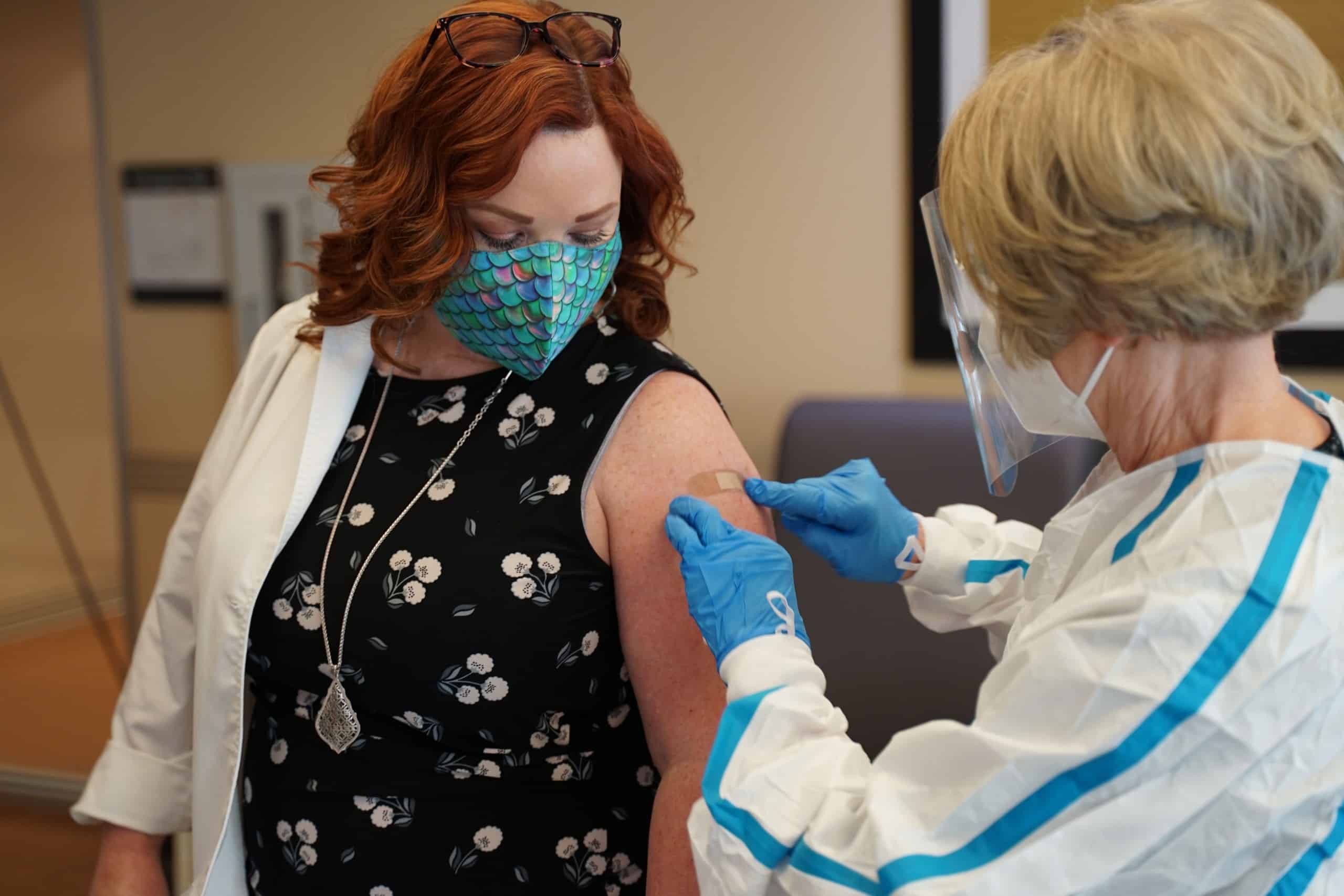Vaccinating frontline providers against COVID-19 is a huge step in keeping our Health Care Heroes safe and allowing them to continue taking care of patients.
When the time came to get it done, our pharmacy team stepped up to overcome challenges and get the job done.
They say it took a system-wide effort, with multiple departments playing a role in the planning process and volunteers from all over Regional One Health stepping up to help.
Every year, our pharmacy team spearheads a major effort to vaccinate Regional One Health staff against the flu. It’s a big undertaking, but a welcome chance to use their knowledge and experience to protect colleagues and patients.
As COVID-19 vaccines became available, pharmacists were the natural choice to take the lead. “Thanks to our flu campaigns, we have experience and infrastructure for getting a lot of people immunized quickly,” said Inpatient Pharmacy Manager Justin Griner, PharmD, BCPS. “We were well-positioned to do a similar effort for COVID-19.”
Still, the new vaccines posed new challenges.
It would take a system-wide effort, led by Marilyn Lee, PharmD, BCPS, Matthew Currie, PharmD, MBA, and Griner, to develop a plan to safely vaccinate hundreds of employees while making sure not a single dose is wasted. “Dr. Marilyn Lee has been the ideal person to coordinate our COVID vaccination efforts in the Pharmacy Department,” Griner said. “Her experience in leading Regional One Health’s influenza vaccinations over the past decade has been invaluable and has been a key factor in making this process run so smoothly and successfully at Regional One Health.”
Griner said employees from every part of the health care system played a role, from the nursing team to procurement to facilities to IT and beyond.
It all started with the hunt for the perfect freezer. Regional One Health learned it would get the Pfizer vaccine, which is stored at negative 70 degrees Celsius, so the first step was working with procurement staff to get equipment to keep the vaccine at that frigid temperature.
“We’d never used a freezer that cold before,” Currie said. “The vaccine comes in pelletized dry ice, and we have to wear special gloves to take it out of the dry ice and put it into the freezer.”
Meanwhile, facilities officials were identifying a location that would allow for social distancing during vaccinations and the mandatory 15-minute observation period; and IT staff were building systems for scheduling and recording data per Shelby County Health Department requirements.

Inpatient Pharmacy Manager Justin Griner said colleagues have been eager to help with the vaccination process. “They feel this is a historic event that they want to be part of. They want to protect their coworkers, and they want to be able to say they helped bring this pandemic to an end.”
By the time the first shot was given, countless hours had gone into planning. Then, administering the vaccinations presented another set of challenges.
For one thing, pharmacists must be extremely precise in the materials they use, Currie said.
They mix thawed vaccine with a specific saline solution to create doses and use special “vanishing point” syringes that promote minimal waste. It’s working: They’ve been able to get six doses out of each vial rather than the expected five, which is crucial to maximizing limited supply.
There are also timing considerations. Once a precious vial of vaccine is thawed, it must be used in six hours or discarded.
“There’s a constant balance between making sure we have plenty of product available and not wasting any,” Griner said. “We have a short window, and wasting vaccine is something we do not want to do under any circumstance.”
They developed strategies, like making sure there are six people waiting to be vaccinated before making the final doses for the day.
Still, a lot of it comes down to making multiple trips between the pharmacy and vaccination site as they get enough patients for a new vial: “There’s a lot of running back and forth to prepare vaccine as we need it. I get a lot of my daily steps in by 8:30 in the morning, which is not normal for me,” Griner laughed.
The fact that the Pfizer vaccine is a two-dose product has recently made planning easier.
For second doses, they check how many people got the first dose the allotted 21 days prior and then thaw vaccine accordingly. Then, because the two doses are identical, they give second doses first and use the rest of their thawed supply for employees who need dose one.
Griner said it’s going smoothly thanks to a huge outpouring of volunteers. Employees from all departments are helping with registration and monitoring, and members of the pharmacy and nursing teams have stepped up to administer vaccinations on top of their normal duties.
Nurse Fay Lewis, RN, wanted to help other people feel comfortable getting the vaccine, so she reached out to Griner to ask how she could help. She has since encouraged her fellow nurses in the trauma intensive care unit to get involved as well.
“As nurses, we take an oath to do no harm, and this is a way we can protect patients, coworkers, family and everyone around us,” she said. “I knew people would be nervous, and I wanted to talk to them and reassure them. I’ve seen our leaders at Regional One Health take the time to talk, listen and answer questions, and it shows how much they care about us. I’m honored to help.”
Meanwhile, pharmacy residents, led by Travis Berkowitz, PharmD and David Ursic, PharmD, had made sure vaccination sessions run smoothly. “Without our residents, this wouldn’t work,” Currie said. “They come in early and stay late to give shots, and it’s high-risk, because you’re exposed to so many people. But nobody’s complained – it’s just part of being in health care.”

Pharmacists have developed strategies to make sure not a single dose of the vaccine is wasted. Once they thaw a vial, they must use it within six hours.
That has been the case for all the volunteers, Griner said. “They feel this is a historic event that they want to be part of,” he noted. “They want to protect their coworkers. They’re excited the vaccine is available, and they want to do everything they can to help people get it. They want to be able to say they helped bring this pandemic to an end.”
That has been Lewis’ experience. Not only is she grateful for the chance to protect herself and others, she’s had fun meeting coworkers she might not otherwise have encountered.
“I leave the vaccination sessions with a huge smile on my face. It’s been one of the best things I’ve done” since starting at Regional One Health in 2013, she said. “I feel blessed that I’ve had a chance to do this. For nurses, it’s chance to turn around our experience with COVID-19. For the past year we’ve struggled to help people get well. This is a way to change our focus to helping keep people from getting sick, and that’s really rewarding.”
That is the biggest message Griner and Currie want everyone to take away.
“The big thing I tell my friends and family is to trust the science, not social media. This vaccine is safer and more effective than any vaccine we’ve ever received,” Currie said.
“My advice is 100 percent get the vaccine,” Griner added. “The risks are minimal and it’s very effective, while the risks from getting COVID are huge – even if you have mild symptoms, you may pass it to someone who doesn’t fare as well. Getting the vaccine is important for your health and to protect your family, friends and coworkers…and the nation.”

